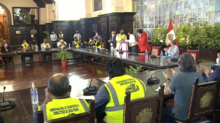2022 Peruvian economic protests
Following widespread rioting on 4 April after the UGTRANM called for a general strike, President Castillo declared a one-month state of emergency, citing intelligence reports of planned violence, and enforced a curfew in the capital city of Lima that was later withdrawn.
[7][8][9][10] According to the Institute of Economics and Business Development (IEDEP) of the Lima Chamber of Commerce, the country's middle class shrank by almost half from 43.6% in 2019 to 24% in 2020 due to the crisis.
[9] Following the global economic reverberations resulting from sanctions against Russia due to the Russian invasion of Ukraine beginning in February 2022, inflation in Peru rose sharply.
[1] According to Convoca, the leader of the Union of Multimodal Transport Guilds of Peru (UGTRANM), Geovani Rafael Diez Villegas, met with President Castillo in August 2021 on behalf of the National Society of Industries (SNI) [es], a manufacturing employers' organization.
[17][18] In October 2021, the website El Foco released recordings revealing a leaked WhatsApp group chat, with Bruno Alecchi of the Permanent Transport Committee of the SNI forwarding messages from UGTRANM leader Geovani Rafael Diez Villegas about a transportation strike organized for 8 November 2021 and shared ideas of support, with the president of the SNI and former Vice President of Peru under Alberto Fujimori, Ricardo Márquez Flores, being mentioned in the chat.
[17][18] Through his tenure, Castillo has chosen controversial individuals to serve in his government and cabinet, with some officials being described by critics as unqualified for their positions – mainly from the Free Peru party he belonged to – while others were allegedly involved in corruption.
[20] A short time later, controversy arose when newspapers reported that Castillo had met with individuals at his former campaign headquarters in Breña without public record, a potential violation of a recently created and a complicated set of transparency regulations.
[29][30] At the same time, UGTRANM leader Geovani Rafael Diez Villegas – who was previously reported to be involved with the Brotherhood of Pisco to remove Castillo from office – announced the beginning of transportation strikes in Peru.
[15] Inflation of basic goods alongside increasing fertilizer and fuel prices as a result of international sanctions on Russia angered rural Peruvians, shifting them from their position of supporting Castillo to protesting his government.
[31] UGTRANM leader Geovani Rafael Diez Villegas himself owed the Superintendencia Nacional de Administración Tributaria (SUNAT) thousands of soles.
[34] During a late night announcement, President Castillo declared a state of emergency and enforced a total curfew in Lima for the entire day of 5 April.
[39] Into the evening, thousands of protesters defiantly formed marches that congregated at Plaza San Martín and attempted to approach the Legislative Palace, where President Castillo was meeting with Congress.
[40] President Castillo travelled to Huancayo on 7 April to attend the Decentralized Council of Ministers at the Wanka Coliseum, with 3,000 police officers deployed to secure the area.
"[41] Representatives of the agricultural and transportation groups present discussed concerns with Castillo while also recognizing the obstruction Congress performed against the president, with one leader and former mayor of the Acolla District, Jaime Esteban Aquino, stating "If they don't understand, the people will also fight against those congressmen.
[44] Despite a truce between the government and some groups, unions in Cusco began protests on 18 April demanding the lowering of prices and the rewriting of the Peruvian constitution, resulting with hundreds of tourists being stranded in some areas.
[13][47] Verónika Mendoza, leader of the left-wing Together for Peru party, criticized the curfew, stating "The Government has not only betrayed the promises of change for which the people chose him, but now repeats the right-wing method of 'conflict resolution': ignoring those who mobilize expressing their legitimate discomfort with the economic and political situation, repressing, criminalizing and restricting rights".
"[48] Former president Manuel Merino, who briefly held the presidency after Vizcarra was vacated, questioned politicians such as Francisco Sagasti, Mirtha Vásquez, Julio Guzmán, Alberto de Belaunde, Gino Costa, Verónika Mendoza and Sigrid Bazán remaining silent in the face of the deceased, unlike with the deaths of Brian Pintado and Inti Sotelo in their short 2020 administration.
[49] The Community of Latin American and Caribbean States (CELAC) released a statement in which it expressed "concern and regret" over the protests and deaths, and urged respect for the "democratic order".
[51] President of Bolivia Luis Arce said that the right-wing in Peru "want to rip off in the streets what they did not win at the polls" and "we have to respect the popular vote of the Peruvian people".
